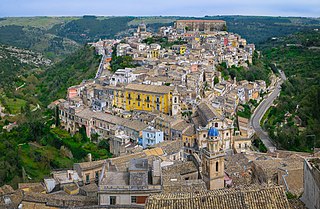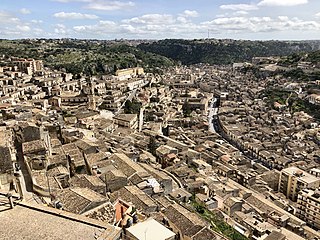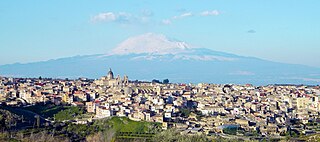
Sicily is the largest and most populous island in the Mediterranean Sea and one of the 20 regions of Italy. The Strait of Messina divides it from the region of Calabria in Southern Italy. It is one of the five Italian autonomous regions and is officially referred to as Regione Siciliana. The region has 5 million inhabitants. Its capital city is Palermo.

Noto is a city and comune in the Province of Syracuse, Sicily, Italy. It is 32 kilometres (20 mi) southwest of the city of Syracuse at the foot of the Iblean Mountains. It lends its name to the surrounding area Val di Noto. In 2002 Noto and its church were declared a UNESCO World Heritage Site.

Ragusa is a city and comune in southern Italy. It is the capital of the province of Ragusa, on the island of Sicily, with 73,288 inhabitants in 2016. It is built on a wide limestone hill between two deep valleys, Cava San Leonardo and Cava Santa Domenica. Together with seven other cities in the Val di Noto, it is part of a UNESCO World Heritage Site.

The Province of Syracuse was a province in the autonomous island region of Sicily in Italy. Its capital was the city of Syracuse, a town established by Greek colonists arriving from Corinth in the 8th century BC. It had an area of 2,109 square kilometres (814 sq mi) and a total population of 403,985 (2016). Syracuse had 8% of the Sicilian population and 8.2% of Sicily's area.
Floridia is a town and comune in the Province of Syracuse, Sicily (Italy).

Caltagirone is an inland city and comune in the Metropolitan City of Catania, on the island of Sicily, southern Italy, about 70 kilometres (43 mi) southwest of Catania. It is the fifth most populous municipality of the Metropolitan City, behind Catania, Acireale, Misterbianco and Paternò. Alongside Catania, it is the only town who is seat of a tribunal in the former province. Since 1987, the comune has obtained the City title, through presidential act. After Caltanissetta, it is the second most populous comune in Central Sicily.

Sicilian Baroque is the distinctive form of Baroque architecture which evolved on the island of Sicily, off the southern coast of Italy, in the 17th and 18th centuries, when it was part of the Spanish Empire. The style is recognisable not only by its typical Baroque curves and flourishes, but also by distinctive grinning masks and putti and a particular flamboyance that has given Sicily a unique architectural identity.

Palazzolo Acreide is a town and comune in the Province of Syracuse, Sicily. It is 43 kilometres (27 mi) from the city of Syracuse in the Hyblean Mountains.

Vincenzo Sinatra was a Sicilian architect. He was a pupil of Rosario Gagliardi. Sinatra worked in both the Baroque style and later in Neo-Classical style.

Modica is a city and comune of 54,456 inhabitants in the Province of Ragusa, Sicily, southern Italy. The city is situated in the Hyblaean Mountains.

Scicli is a town and municipality in the Province of Ragusa in the south east of Sicily, southern Italy. It is 25 kilometres (16 mi) from Ragusa, and 188 kilometres (117 mi) from Palermo, and has a population (2017) of 27,051. Alongside seven other cities in the Val di Noto, it has been listed as one of UNESCO's World Heritage Sites.
Giovanni Battista Landolina, "Marchese di S. Alfano", was a Sicilian landowner and intellectual instrumental in having the city of Noto removed from its former site on Mount Alveria to a more level location following the earthquake in 1693 centred on the Val di Noto. He is commemorated by a piazza in the city named in his honour.

Buscemi is an Italian town and comune (municipality) of 968 inhabitants of the free municipal consortium of Syracuse, in Sicily.

Giuseppe "Pippo" Fava was an Italian writer, investigative journalist, playwright, and Antimafia activist who was killed by the Mafia. He was the founder of the I Siciliani, a monthly magazine. His motto in life was "Is there any use in living if you don't have the courage to fight?"

Militello in Val di Catania is a comune (municipality) in the Metropolitan City of Catania in the Italian region Sicily, located about 160 kilometres (99 mi) southeast of Palermo and about 35 kilometres (22 mi) southwest of Catania, on the last slopes of the Hyblaean Mountains. It has a railway station on the line Catania-Gela.

The 1693 Sicily earthquake struck parts of southern Italy near Sicily, Calabria, and Malta on 11 January at around 21:00 local time. This earthquake was preceded by a damaging foreshock on 9 January. The main quake had an estimated magnitude of 7.4 on the moment magnitude scale, the most powerful in Italian recorded history, and a maximum intensity of XI (Extreme) on the Mercalli intensity scale, destroying at least 70 towns and cities, seriously affecting an area of 5,600 square kilometres (2,200 sq mi) and causing the death of about 60,000 people.

Akrai was a Greek colony founded in Sicily by the Syracusans in 663 BC. It was located near the modern Palazzolo Acreide.

36°53′29.76″N15°4′15.53″E

During the Muslim rule on Sicily, the island was divided into three different administrative regions: the Val di Noto in the southeast, the Val Demone in the northeast and the Val di Mazara in the west. Each zone has a noticeably different agriculture and topography and they converged near Enna (Castrogiovanni).

The Monastery of San Nicolò l'Arena in Catania, Sicily is a former Benedictine monastery, located on Piazza Dante 30 in the city of Catania, region of Sicily, Italy. After the Mafra, this abbey is the second largest Benedictine monastery in Europe. It is now a UNESCO World Heritage Site, and houses the Department of Humanities of the University of Catania.




















